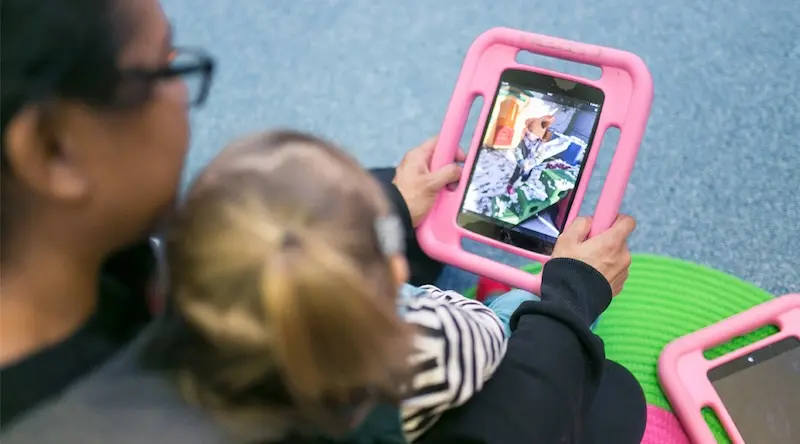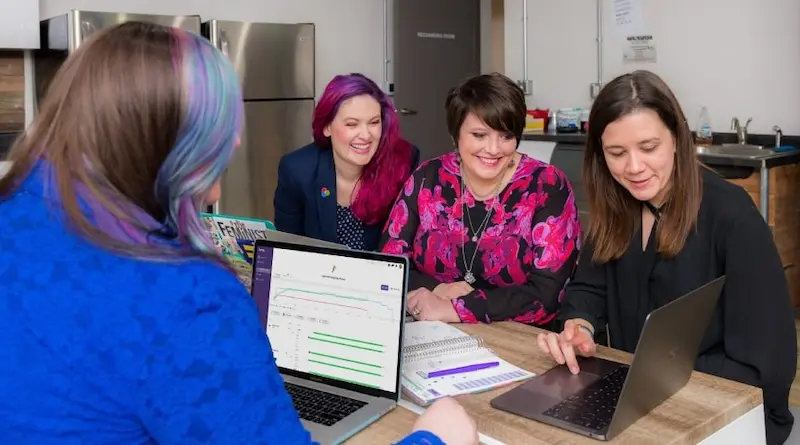settings
children
With Famly since
As time goes by, more and more early years settings are choosing to make the switch from paper-based management to an early childhood platform that provides a helping hand with their day-to-day work.
As the demand for effective software continues to grow, so do the options. Solutions like Connect Childcare, eyLog, Kinderly, Blossom, Parenta, and (of course!) Famly, are all competing to provide an experience which makes life easier for staff and parents in the Early Years.
So how on earth are you meant to choose?
Well, it’s important to bear in mind that no two systems are the same. While many might share similarities, sometimes those small differences have the biggest impact on saving you time, improving parent partnerships and helping every child to thrive.
That’s why we’ve compiled this summary of what to look for when choosing software to use in your setting. Whether it’s the first time you’re moving away from paper, or you’re simply looking for a change from your current system, we hope this guide can help to narrow down your choice.
The big ideas
Quick tips
Before we get started, here are some of the key things to consider before starting your search for an early childhood platform.
- Never compromise on your requirements – Not all systems will work for everyone, draw up a list of your unique needs before you get started so you can find the right fit for you.
- Listen to what others are saying – Join Facebook groups and online discussion boards to ask questions and get a sense of the general experience people have had with different system providers.
- Think of the parents – Choosing software that is easy to use and makes parents feel involved can have a big impact on your reputation with current and prospective parents alike.
- Support and training – Does the provider have quality training resources and on-demand customer support? Try to find out from existing customers how easy it is to get hold of the support team.
- Find the hidden costs – Bear in mind that some system providers may have extra costs such as set-up fees or expensive training which you’ll need to front in order to get started.
- Does it work everywhere? – Consider how different parts of the system work together or whether you’ll be doing a lot of double data entry. Does it work across all your devices?
- Ease of use – The system you choose is only as valuable as what you put into it. Make sure that it’s intuitive and easy to use for every member of staff.
- Can it handle the money? – Billing is one area that can be a challenge for some systems, especially with the variety of ways billing can be done. Make sure you check that your way of billing can be accounted for.
- Hear about it first-hand – Once you’ve narrowed it down, ask preferred providers to connect you with local settings so you can hear first-hand about their experiences with the platform.
- See it in action first – Make sure to get a proper demo and get all your questions answered before making any final decisions.
- Can you escape? – Find out whether the platform requires a fixed contract or penalty for leaving the platform if things don’t work out.

The ‘essentials’
What sort of basics does the system need to truly make a difference, rather than just get in the way of what you currently do?
These are what we think are the core elements of what a digital system needs to help make your setting tick, as well as some of the things parents might expect and what can help you with Ofsted.
Bear in mind that having a system in place should make things significantly faster and more straightforward. If you find that the system is actually eating up more time than ever, even once you’ve got used to it, it might be time to look elsewhere.
- Child development – Being able to quickly record observations, view learning journals, and any necessary checks or baseline assessments is one of the key reasons you might choose to take your setting digital. Of course, it's useful to have the right reference material for your curriculum in-app too.
- Parent communication – Gone are the days of sifting through a hefty address book to call or email parents – easy contact via direct messaging is now considered the norm. Sharing photos, videos and other updates, throughout the day is also a great way to keep them engaged (check out what we do to keep parents at the heart of your ethos).
- Invoicing and public funding – We’ll admit, sending out invoices isn’t the most enjoyable task and can also be one of the most time-consuming elements of running a nursery. But it t has to be done. Look for systems that can quickly generate batch invoices based on the children's booking patterns and any public funding which needs to be accounted for.
- Ratios and room planning – Getting staff-to-child ratios is a vital responsibility when working in the early years. Letting a digital system take care of the heavy lifting here can help you more easily plan staff rotas and save hours of your time to be better spent elsewhere.

- Accident reporting – Software can be really good for collecting, analysing and reflecting on accident and incident reports to get an overview of events happening within the setting and make the necessary changes.
- Daily child logs – All the happenings in the life of a child at your setting such as nappy changes, meals and snacks, and nap times can be recorded much more quickly on a learning journal-like digital system.
- Cloud-based – Working across devices where information is updated in real-time through the cloud helps staff and parents to see a consistent picture of what’s going on at the setting, without the need for messy double-data entry.
- Customer support – When you’re unsure about how to do something within the platform, is there someone to turn to for help? What about the option to get detailed information in-app? Are support articles available for when you get stuck?
- Document storage – Place to save those important files, with different access based on staff role can help you to work collaboratively and share policies, procedures, and training materials, as well as keep the right things confidential.

The ‘nice to haves’
What extras could the system offer to help you gain even further insight into your setting and make improvements to your processes?
While some of these features are likely to come at an extra cost, they are often the ones that can save you a great deal of time, give parents an even better experience, and streamline your processes. That’s why it’s worth doing a proper analysis of these features and what they could do for your setting before you make any final choices.
- Customised reporting and analytics – Be it advanced debt and revenue forecasting, or occupancy analysis to predict and improve future capacity, this is the ‘big data’ that can help you to make more informed business decisions.
- Enquiries and waiting lists – When you have frequent interaction with new potential parents from the community it’s great to have a centralised place to manage relationships, communicate, and plan ahead for the children that may soon come into your care.
- Sign-in screen – Registering children can easily be one of the busiest periods of the day, and letting parents check themselves in with a straightforward screen can speed up and secure the process.
- Parent-requested care – Ad-hoc additions, like requesting extra sessions and lunches, are a great way to increase revenue and fill up vacant sessions at your setting, letting parents quickly and easily do this in-app is a sure way to boost that occupancy.
- Holiday, sickness, and permission requests – Requests and notifications from current parents for holidays and sick leave come in left, right and centre. Managing these in a centralised way can ensure both the nursery staff and parents don’t miss any important information.
- In-app payment handling – Provide an even smoother experience for parents and avoid handling cash, bank transfers, cheques and reconciliation by having payments integrated into the platform.
- Automation – Some of the more basic tasks you complete on a daily basis are also the ones that are a big drain on your working hours including things like room moves and debt collection. At the click of a button, these simple tasks can quickly and easily be automated in some systems, to help you save hours of bureaucracy.

The ‘timewasters’
What features are (in most cases) actually unnecessary and can complicate the running of your setting for yourself, staff, or parents?
It could be tempting to go for the system which seems to have significantly more options, settings, and customisability than competitors. We’d argue against this though due to the confusion, extra costs and reduced frequency in updates to what’s important.
Some of the things to think twice about:
- Next step suggestions – Every child is unique and will be following their own developmental path. The staff working with that child will know them best, including how to support them in their continuing development.
- Complicated observations - Observations should be simple, so staff can capture what a child is doing and go right back to interacting with them. Watch out for systems that require staff to go through multiple steps, several text boxes, or time-consuming curriculum statements just to make an observation.
- An excessively bulky platform – Even though it might seem nice to have endless features, the reality is mess and confusion. Whichever system you choose should have the flexibility to do what you need, but not be so expansive that it confuses your staff or parents.
- Locally stored data – Systems that aren’t cloud-based end up meaning data is not consistent for all users. There’s also the risk of accidental deletion, data loss or unwanted access due to damage or theft.
- Separate apps or systems – Instead of one, unified system, some providers offer different apps for different people or specific use cases. This complicates the way the system works together as an integrated whole, leading to double data entry, slower updates and the launch of new features, resulting in a messy experience for staff and parents.
- Large upfront costs – These are there to tie you in and make it harder to leave if you’re unhappy. Many providers also state that you need to pay extra for training. In reality, training should be included, or it should be simple enough that you can handle a lot of it yourself.
Try before you buy
Try every Famly feature, see what you like, and invite your staff. No commitment, no credit cards. Just a 2-week free trial.
Start free trial









